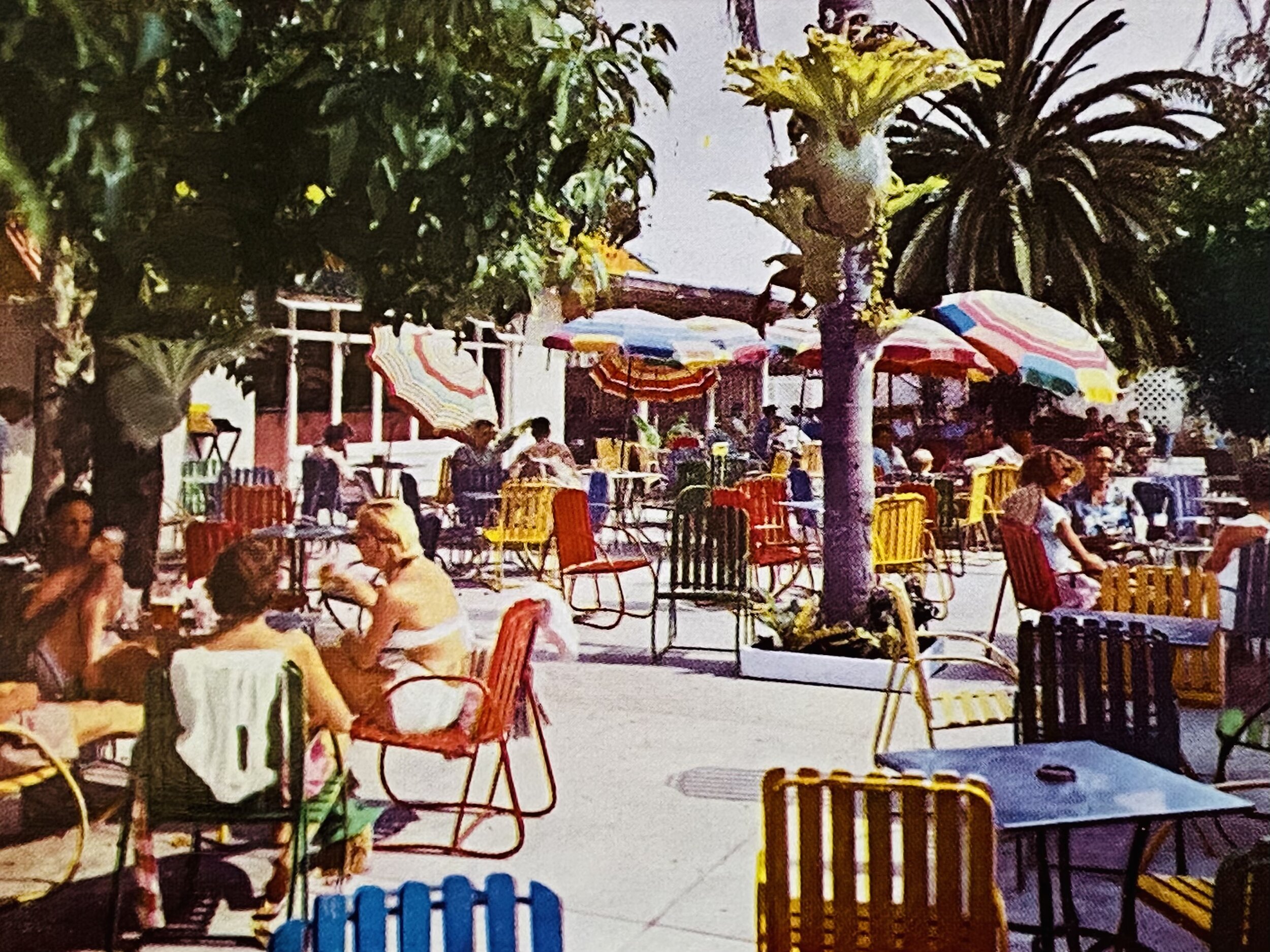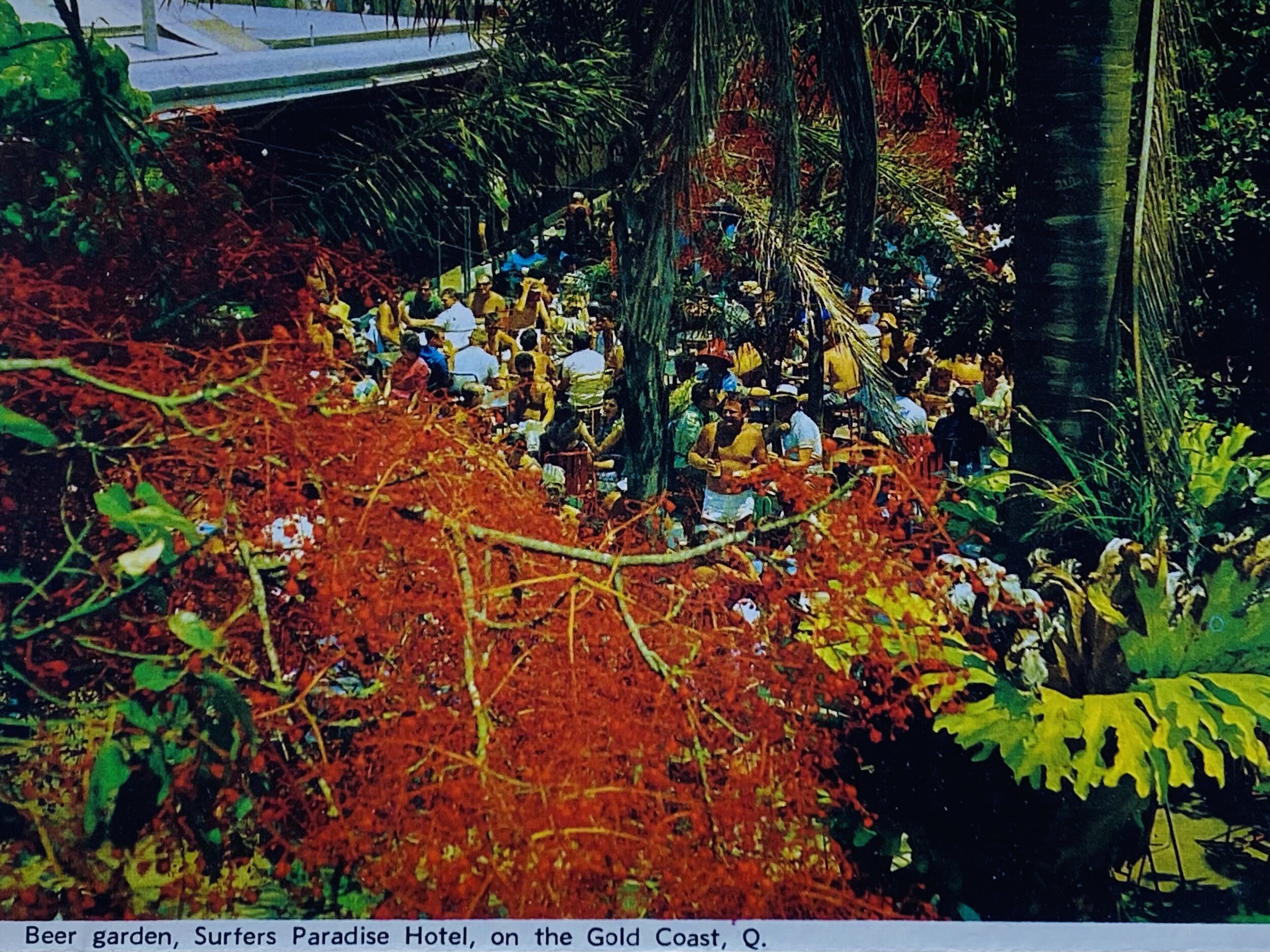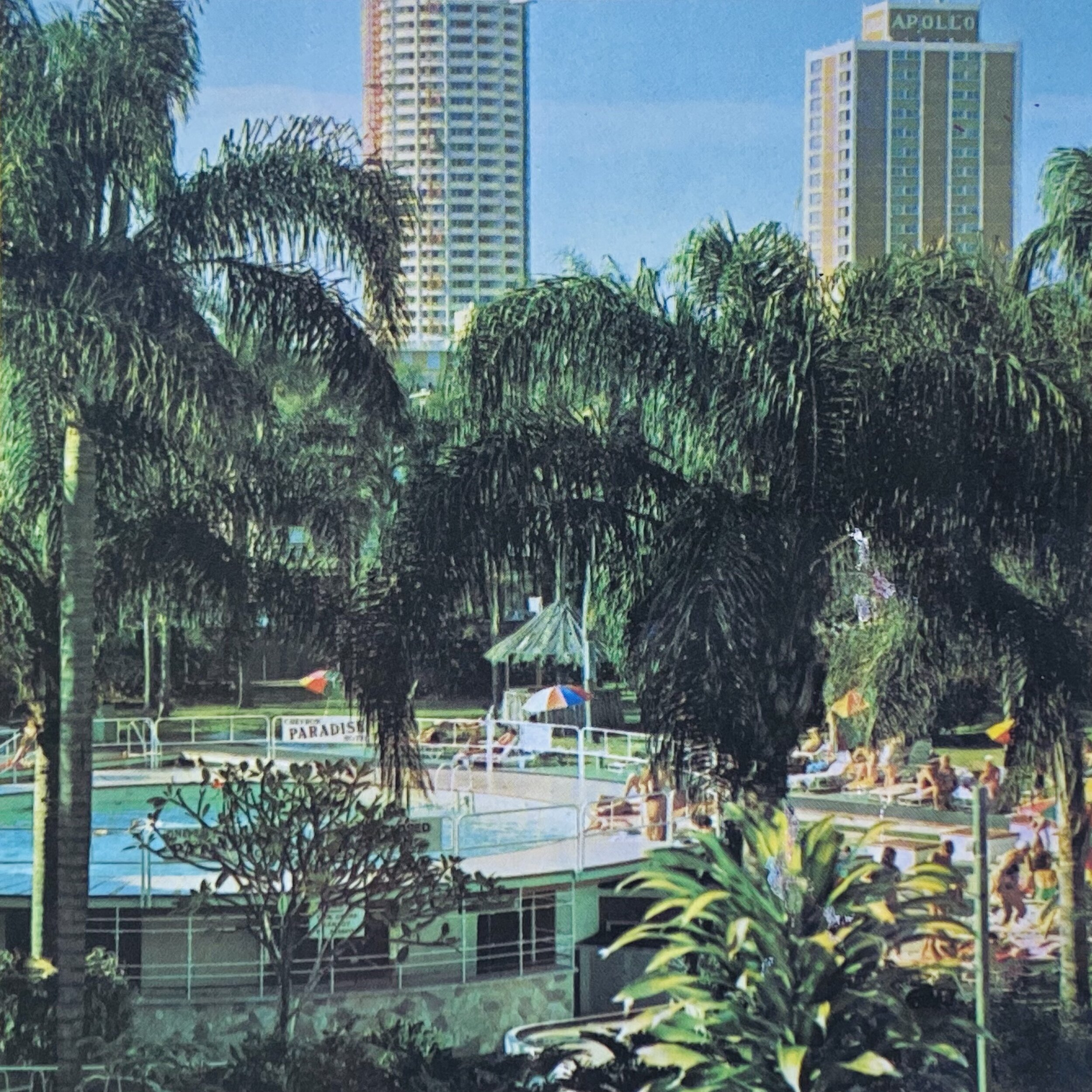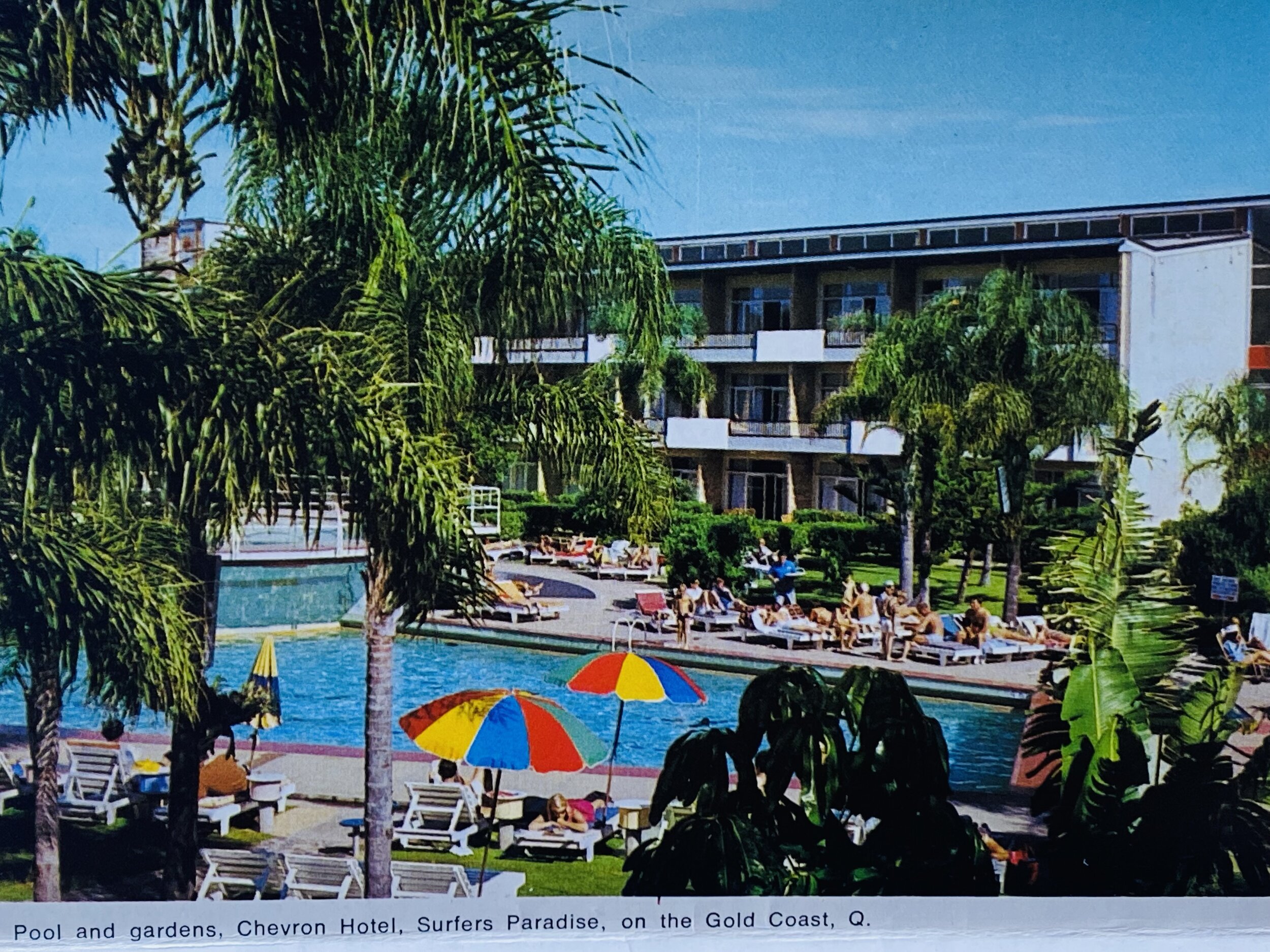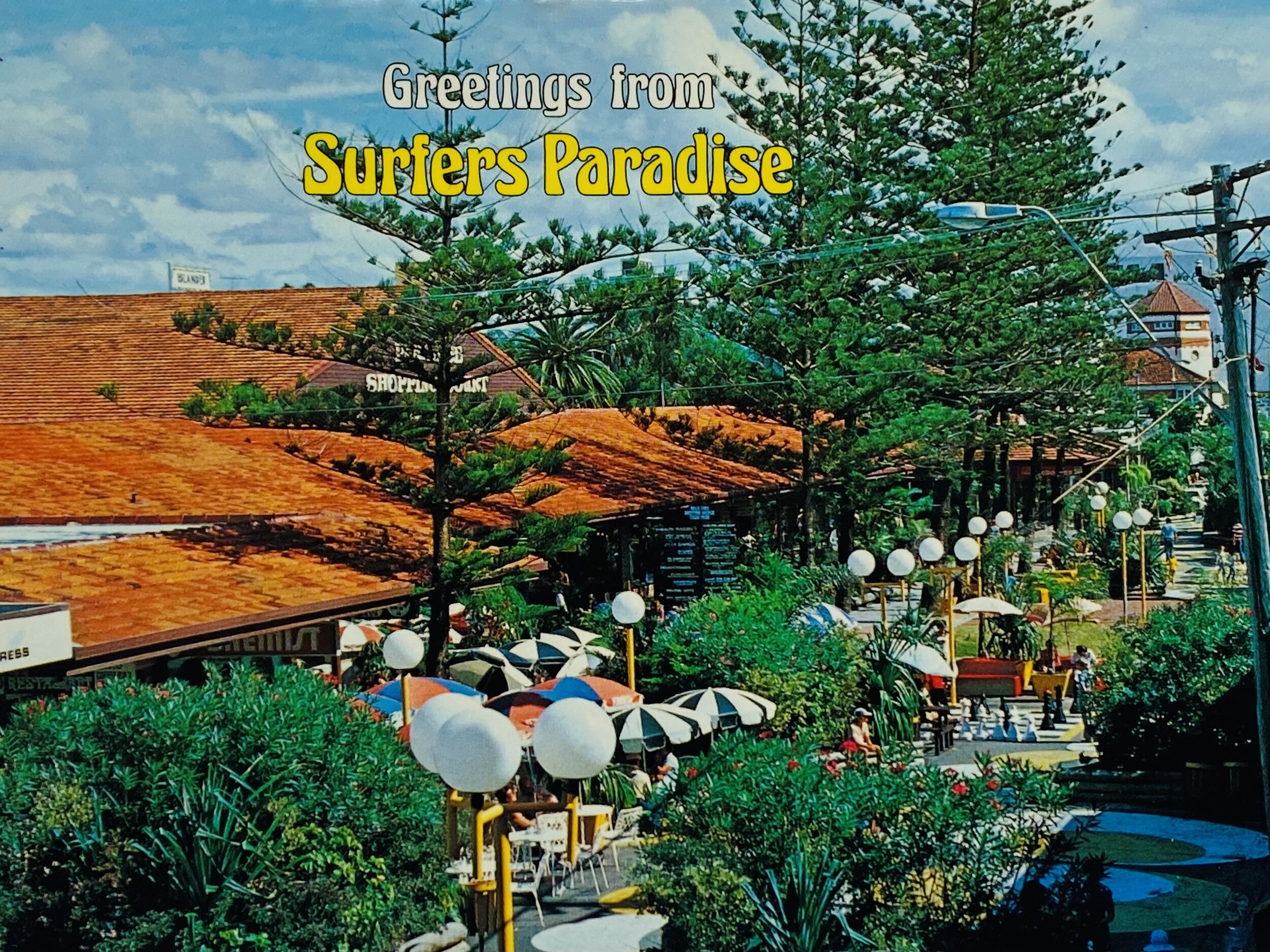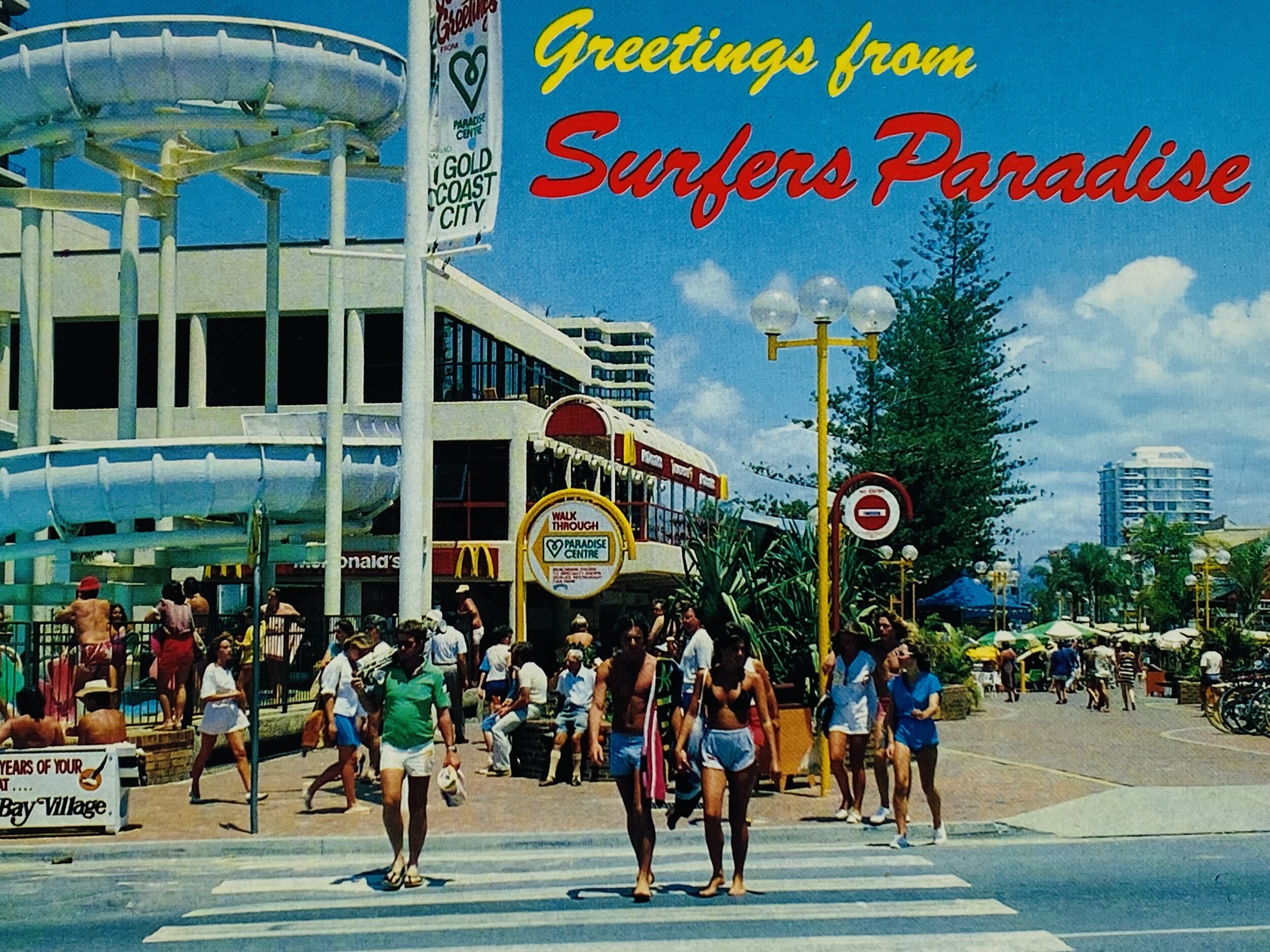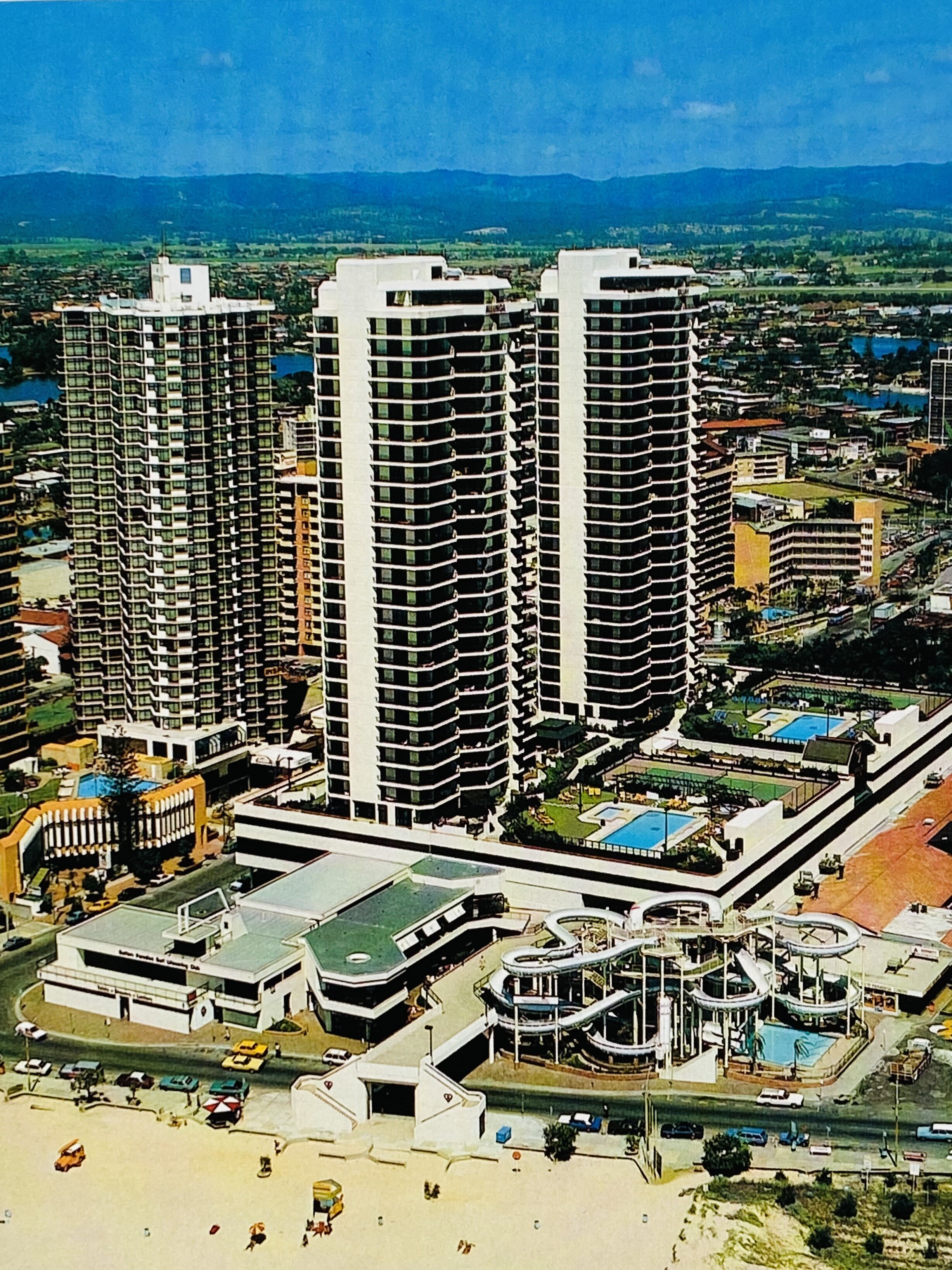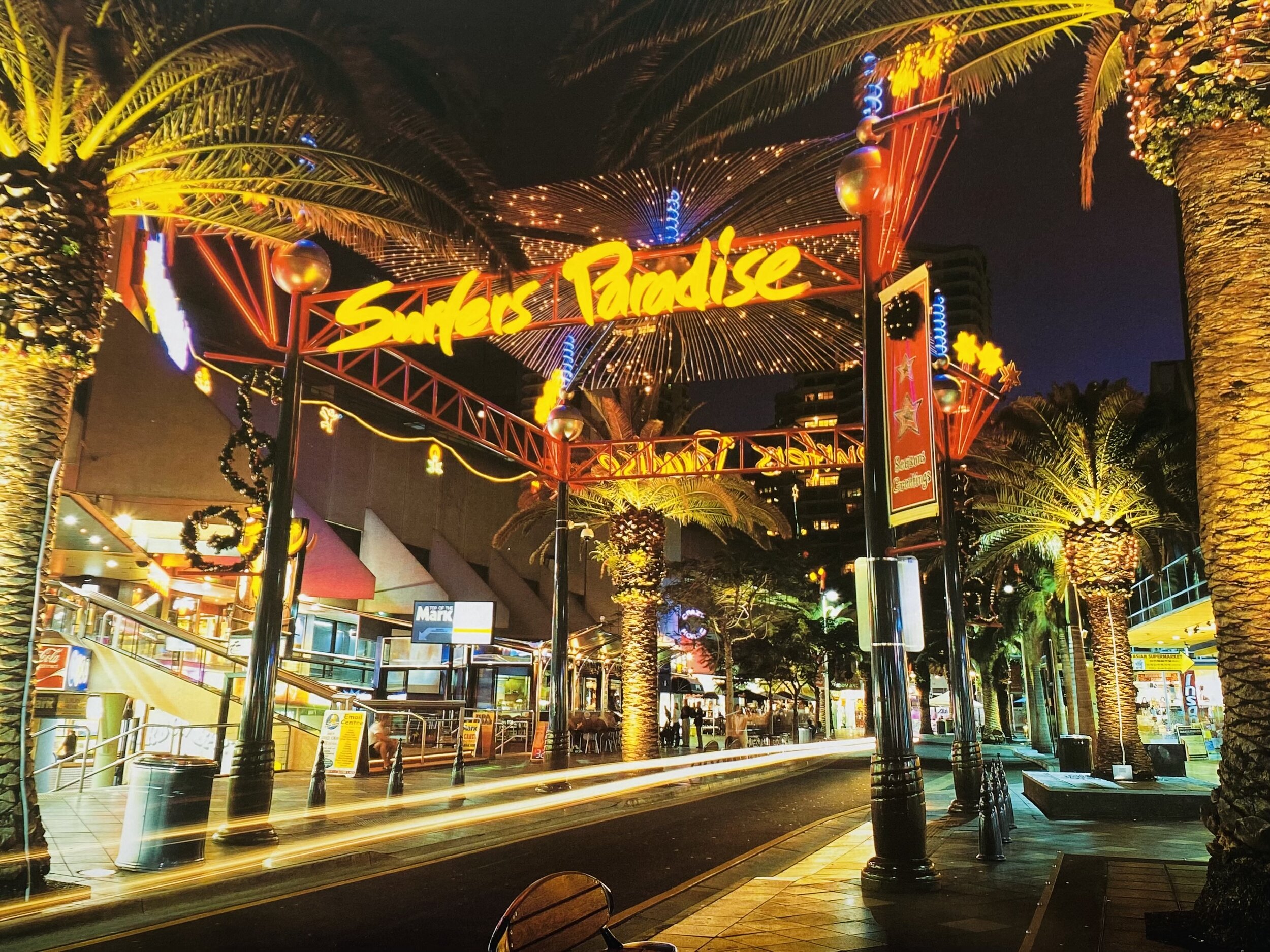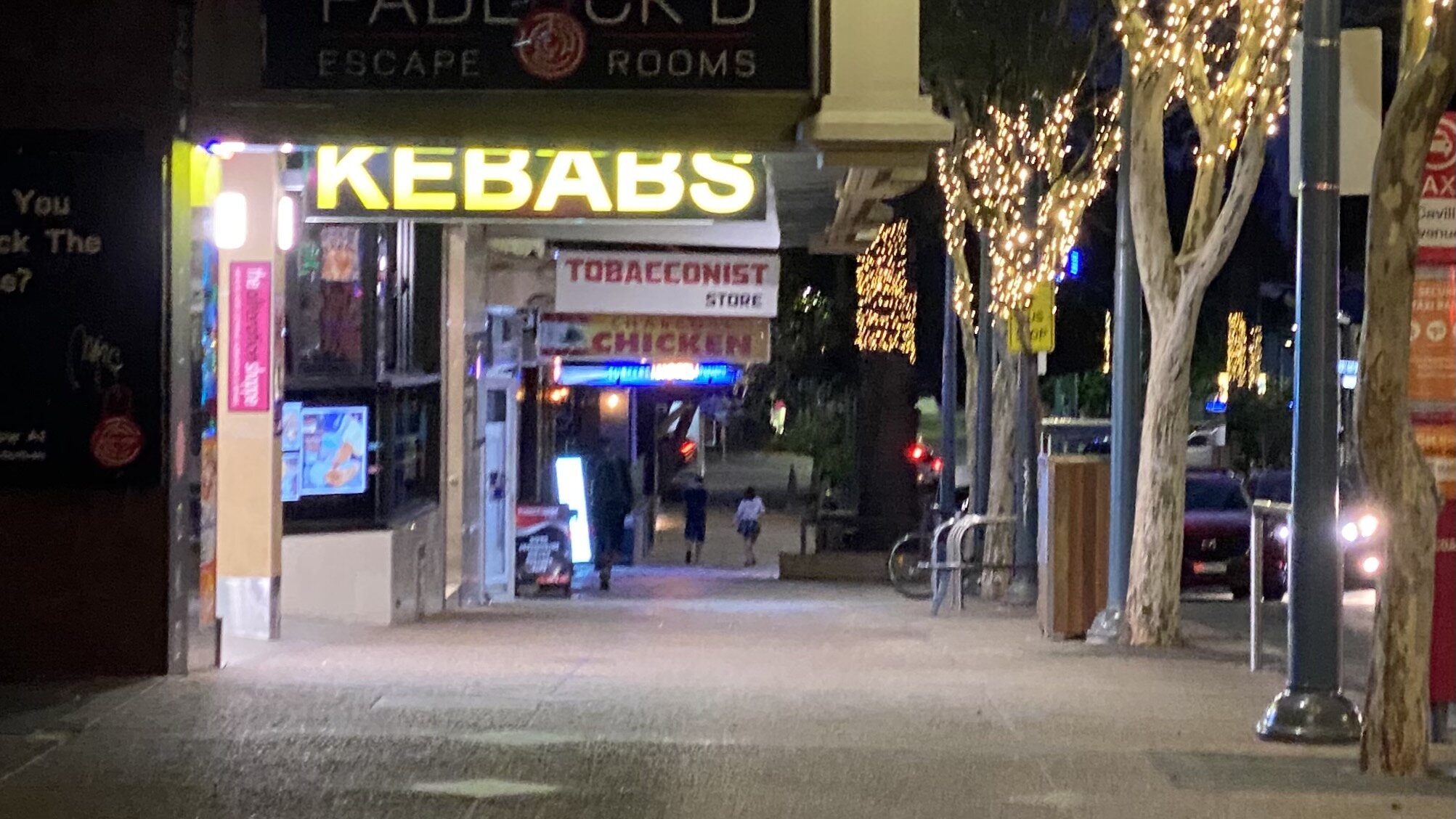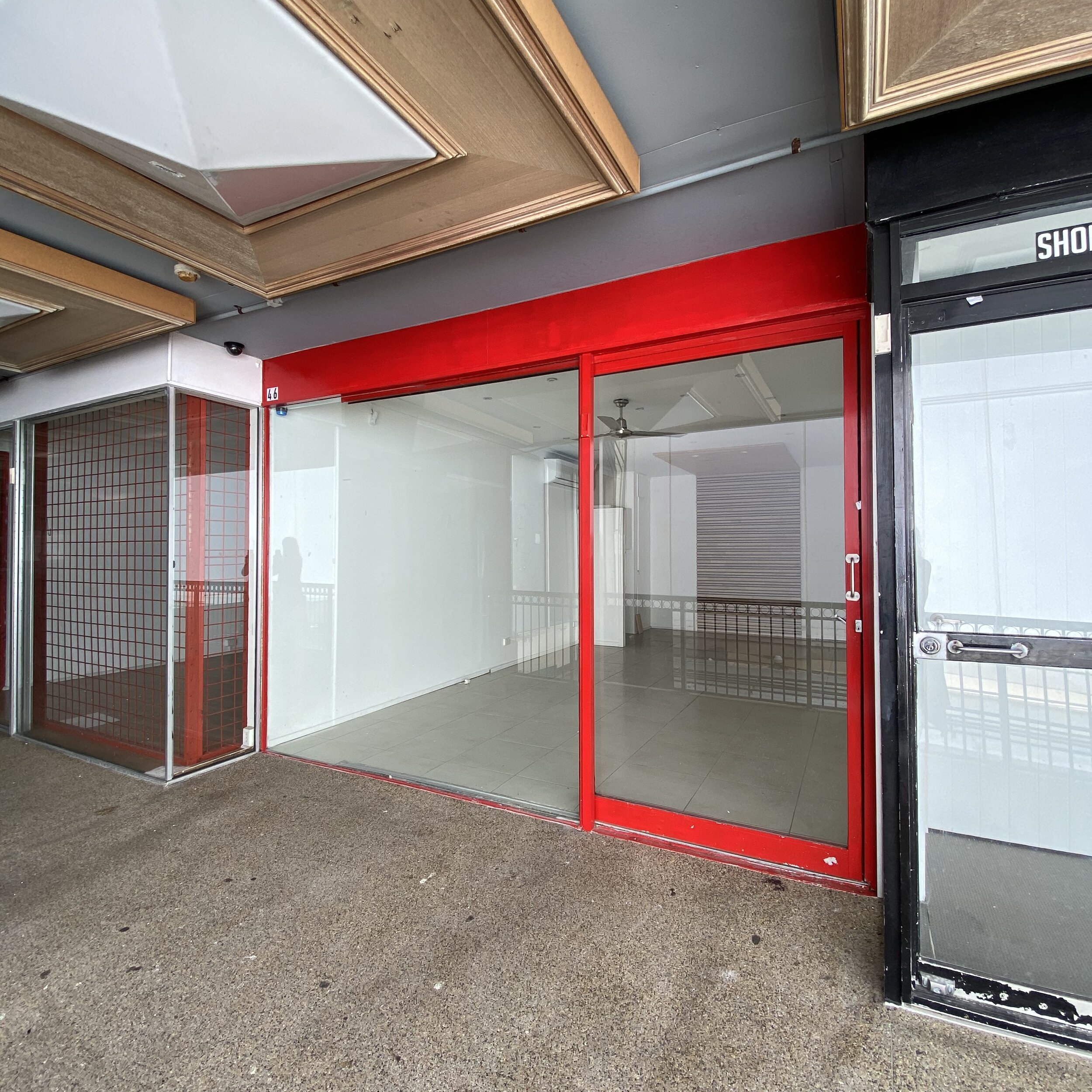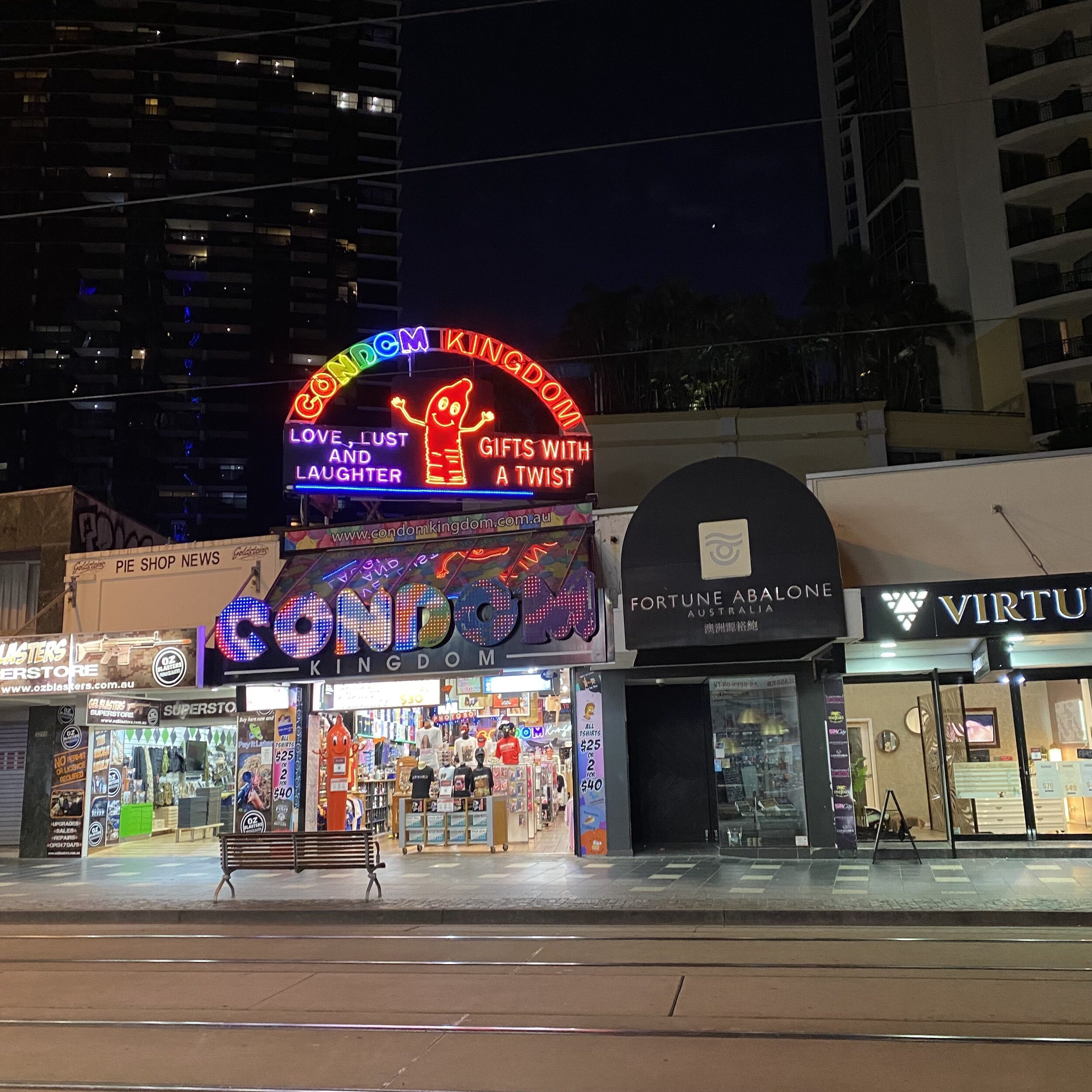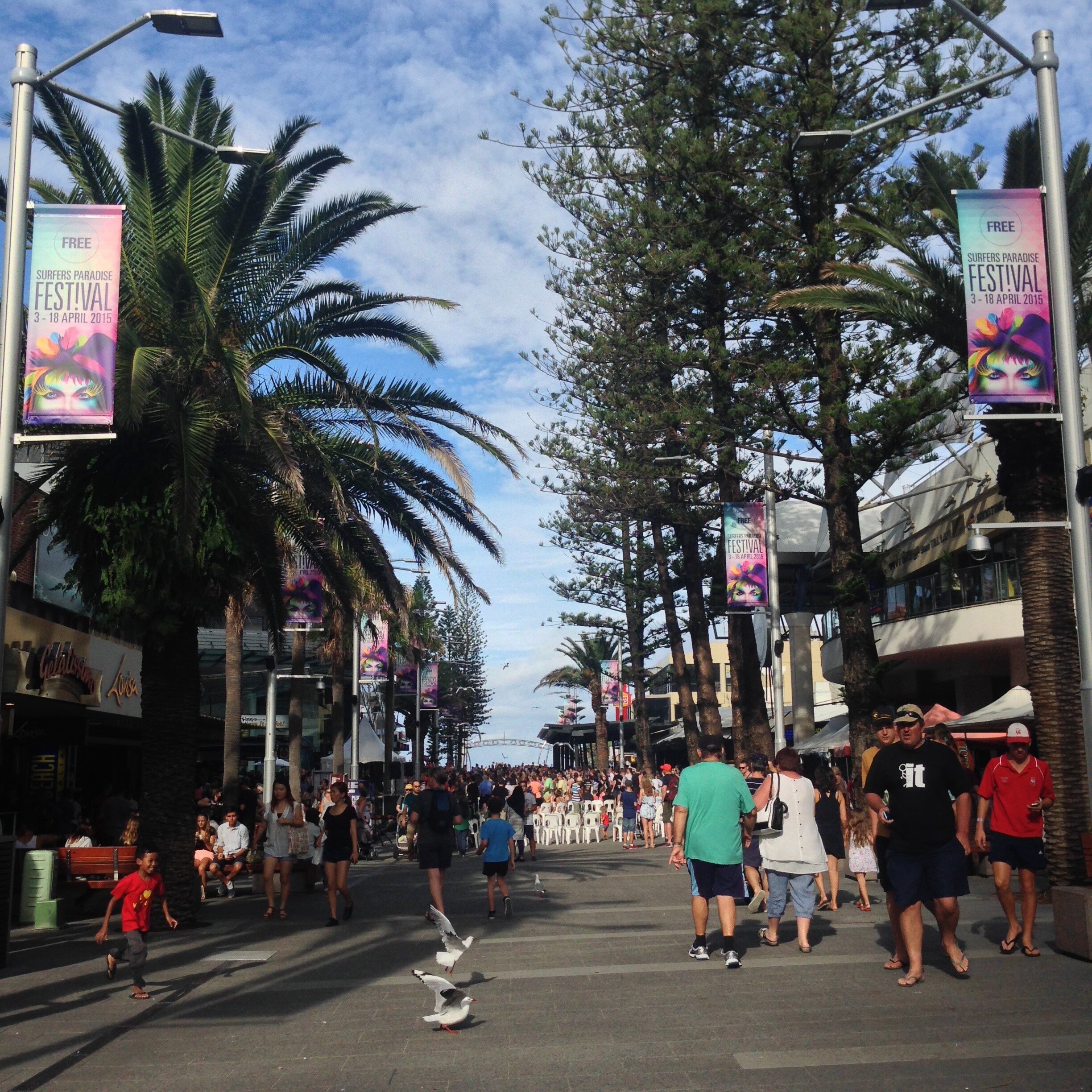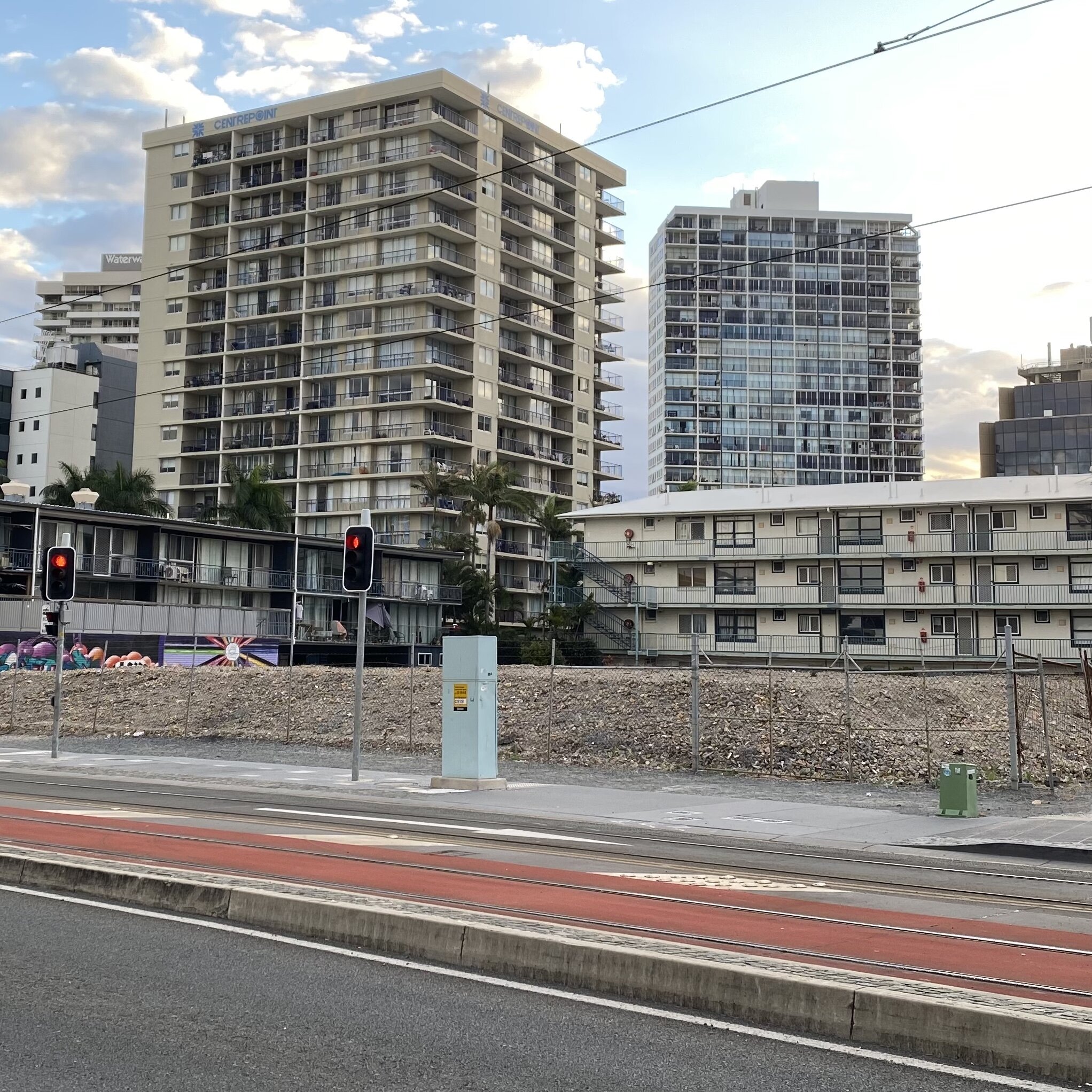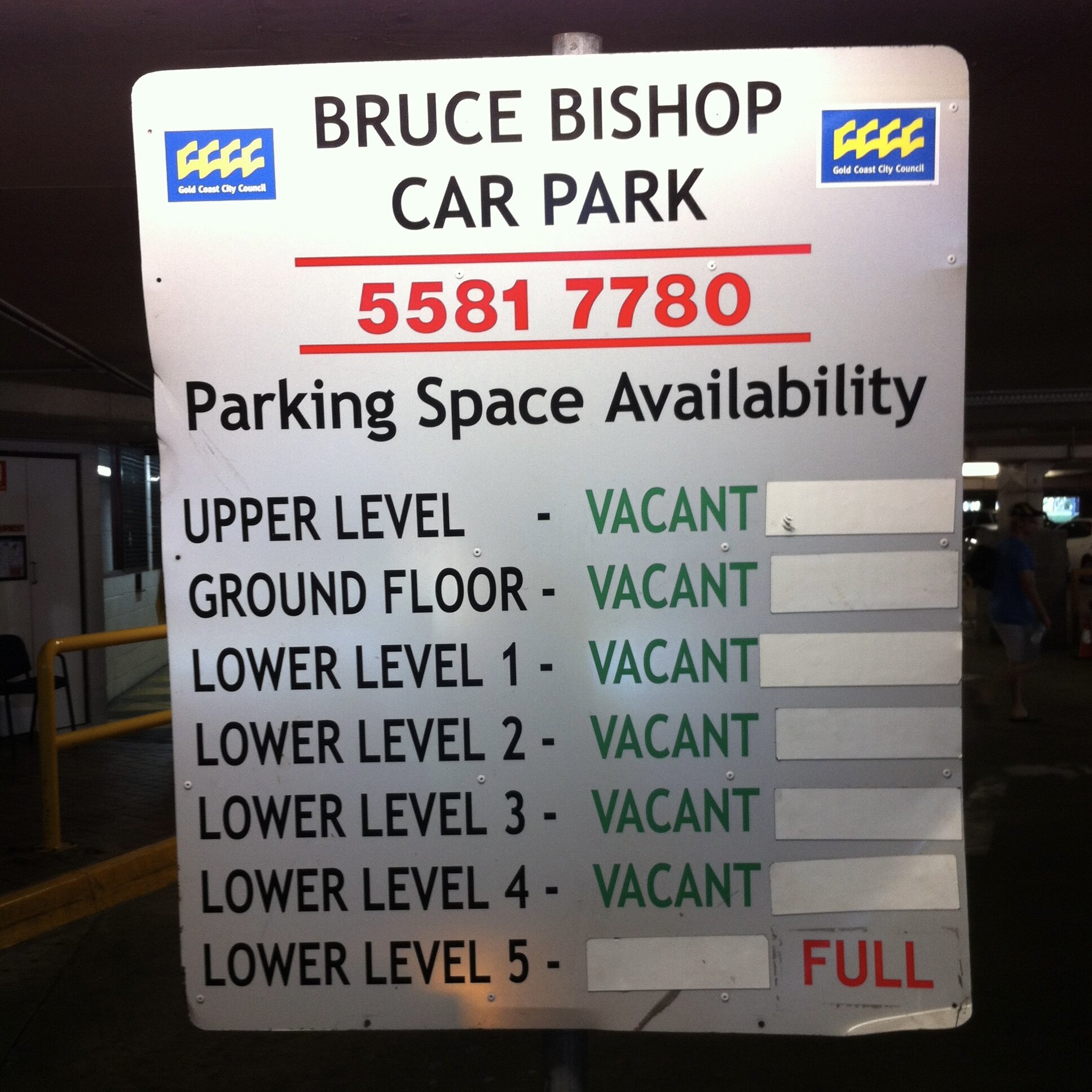Repost @bmaryd #fridayflashback to the 1960s - my teens - in Surfers Paradise when it was a great place. There was always a roving photographer! I’m wearing my homemade (by me) brown batik shift dress. Note the Ansett ANA sign in the background. Oh, and the Coppertone one! Apart from the fact that I have no wrinkles I love this memory of a simple time. I feel we were the lucky generation. The second photo is of my brother and me at the BBQ in Cavill Avenue where our parents would take us for dinner in January. They would always have one special dinner at Margot Kelly’s as well.
My reaction to this Instagram post of Mary in 1960s Surfers Paradise surprised me. It wasn’t her pretty smile, or the background images of the umbrella tree or vintage cars and signs. It was the unmistakeable tone of lament in Mary’s comment about Surfers Paradise: ‘when it was a great place.’
When it was a great place. When it was a great place. When it was a great place. I have listened to this narrative since I moved to the Gold Coast in 1994 when I bought a unit in Surfers Paradise and started work with the council’s town planning department. As a new arrival, it was apparent to me that Surfers was in decline. Its popularity was waning and the surrounding built environment was deteriorating, but I recognised the intrinsic attributes and development potential of the place. I was confident with my investment, and I held out a lot of hope in the future of Surfers Paradise.
Those of us too young to have experienced Surfers Paradise in the 1960s can only imagine what the place was like as it was fast becoming Australia’s premiere holiday destination. Historical photographs, postcards and film footage help us to visualise streetscapes back then, but unsolicited comments, like Mary’s, from the people with lived experience of the place are like gold. Because they can take you straight to the moment and supplement the historical record with sentiment, giving you a sense of what it was actually like to be there. For me, with a keen interest in cultural landscapes and urban design, these comments prompt further thought and inquiry.
My first thought was to imagine sixty years prior, to the turn of the 20th century when Meyer’s Ferry provided the only crossing across the Nerang River from Southport to the nascent settlement of Elston at the river end of what is now Cavill Avenue. How did the Aboriginal Traditional Custodians feel about changes to the natural landscape through farming and timber milling, then later, the construction of roads and accommodation for holidaymakers? All these developments destroyed their middens, cleared vegetation and flattened the dunes. Did they think about the overstory and long for times past, stretching back millennia, when this was a great meeting place of river, land and sea, unrecognisable from 1960s Surfers Paradise? And how about looking forward sixty years from now? Can we even approximate what future Surfers Paradise will look like? Thanks to Mary’s inadvertent comment, I have felt compelled to write and share some thoughts about Surfers Paradise.
SWINGING SIXTIES
From what I have gathered, the beach at Surfers was always the main attraction. But Surfers in the 1960s was also unique for its al fresco cafes, invigorating the streets with their casual furniture, bright umbrellas and of course people on holiday. In the central area, narrow arcades cut through the streets, providing safe, easy, sheltered access to a variety of restaurants, fashion shops and entertainment businesses. Planted Norfolk pines gave structure and shade to most east-west streets, and there were entertainment venues set in tropical gardens, like the Surfers Paradise Hotel Beer Garden and the Chevron Hotel. Motels like Tiki Village, Beachcomber and El Dorado featured fabulous gardens with pools that could be seen from the streets. Even holiday flats and guesthouses, most notably Uncle Tom’s Cabins, presented their gardens as a drawcard. The whole precinct was walkable and lively and inviting. You could step off the beach and into a shaded garden. It felt like an integrated resort, a paradise, albeit with a growing problem of car parking.
BOOMING SEVENTIES AND EIGHTIES
In the 1970s and 1980s, attractions like mini-golf courses and the waterslides of Grundy’s entertainment centre brought water, gardens and activity into the streetscapes, adding to the resort ambience of Surfers.
The first 1970s highrise hotels stretched north along The Esplanade. Buildings like Iluka, The Chateau, Apollo and Focus provided large pool and garden areas that were visible to people walking by and also from high above from apartments in these tall buildings. From 1974, private development and public works were guided carefully by the Surfers Paradise Central Area Plan known as ‘The Gold Book’ which set a vision, urban design codes and a series of 13 Action Projects like car parking stations, a convention centre, pedestrian network, riverfront boardwalk and even design standards for street furniture, signs and graphics.
From 1975, to address the nagging problem of car parking, the council required all new highrise accommodation developments to make 15-25% of their car spaces freely accessible and available for public use. Where adequate car parking spaces could not be provided on site, developers made cash in lieu contributions equating to the shortfall, and thereby contributing towards the funding of what was to become the Bruce Bishop Car Park and Surfers Paradise Transit Centre in 1991.
Development of the Paradise Centre in 1981 incorporated a new Surfers Beer Garden, but it was elevated upstairs and more like a tavern than a garden. In 1982, the beach end of Cavill Avenue was converted to a pedestrian mall to enhance the ritualistic activity of strolling. During daytime and evenings, people wandered between the beach and the river, and along the beachfront to gaze at the striking tall buildings, pools and gardens. It was also popular to cruise the long, straight esplanade by car, and even do laps with windows down, sightseeing. At the river end, Tiki Village Motel, and its Hawaiian garden, was replaced by a new Tiki Village Hotel with a pool and landscaped open space; but again, this area was elevated, privatised and rendered invisible from the riverside or Cavill Avenue.
As complexes like The Mark and Raptis Plaza were developed, connective arcades enriched the sense of Surfers Paradise as an integrated resort. 1980s highrise buildings, like Golden Gate, Hi Surf, Imperial Surf and Peninsula, grew taller and extended farther from Cavill Avenue and the beach, consolidating the distinctive image of Surfers Paradise, synonymous with the Gold Coast, as a place quite different to other Australian cities.
The beach was still the main attraction, but the city also was thrilling and fun. Highrise accommodation gave a novel holiday experience for most visitors who came from lowrise suburban areas. Surfers Paradise was colourful and garnished with abundant tropical greenery. It was a great place to meet up with friends, to eat out, to wander and promenade, and after dark it turned into a lively nightclubbing scene where locals mixed freely with tourists, a party town ‘where the fun never sets’.
DECLINING NINETIES AND NOUGHTIES
Global economic recession of the early 1990s brought a hiatus to development, and by the mid-90s, decline had set in at Surfers Paradise. Grundy’s waterslides were dismantled, and the beach end of the Paradise Centre was left vacant. Large sites that had been bought and cleared by foreign investors were deserted, like bomb sites, and became stains on the image of central Surfers Paradise.
The 1994 Gold Coast Planning Scheme introduced detailed Development Control Plans for most of the city’s activity centres —except Surfers Paradise. This regrettable omission was because the planning work was not adequately advanced to be incorporated at the time of gazettal. The central area was designated in the Comprehensive Development Zone wherein town planning consent was required, but by now, almost anything was allowable. This planning scheme incentivised amalgamation of sites and, in particular hotels with active, commercial uses in the first three storeys. There was a graduation of building height controls stepping away from the beach to lessen shadow impacts on the beach. The scheme provisions for International and Resort Hotels promoted very tall buildings with deluxe facilities and leisure gardens that would attract international tourists. This did indeed result in developments like The Moroccan, Crown Towers and Sun City, that bucked the general economic downturn.
As the recession continued, many commercial premises in the heart of Surfers were vacated. At the same time, shopping centres like Pacific Fair, Robina, Helensvale and Harbour Town emerged to provide Gold Coasters with greater choices and hassle-free car parking.
Through the nineties and noughties, a number of council and local business initiatives sought to revive Surfers Paradise. Cavill Mall had several face-lifts. Wayfinding signs, new footpaths, street furniture, Phoenix palm trees and several public artworks were installed in Orchid Avenue. The top end of Elkhorn Avenue was promoted as a fashion precinct like Rodeo Drive and tenanted for some years by global luxury retailers.
The 2003 Gold Coast Planning Scheme incorporated a Local Area Plan for Surfers Paradise. Landscaping at ground level was mandatory in all but the pedestrian epicentre of the precinct. Here, developments were expected to achieve seamless interfaces with and make contributions to upgrading of appurtenant public spaces. Chevron Renaissance, Circle on Cavill, Soul and Q1 were major developments that boosted their immediate localities, a bit like urban acupuncture, with active ground level thoroughfares, but the gardens for the paying guests and residents of the accommodation towers were all elevated out of sight above street view.
Over time, outdoor dining became regulated, bringing with it permanent physical barriers, and shade structures which annexed public spaces to the extent that in some places that they sought to deliberately alienate pedestrians.
Increasingly problematic drug and alcohol related behaviour, and of course the annual Schoolies takeovers each November, demanded a lot attention and management.
Contrary to the piecemeal decay of public space, the 2011 foreshore upgrade between Laycock Street and View Avenue created a pleasant, unifying and enduring improvement that has perhaps saved Surfers Paradise from more serious demise.
UNCERTAIN TEENS
For much of the past decade, while the rest of the Gold Coast has burgeoned, Surfers Paradise stood still. Disruption caused by light rail stage 1 during 2012-14 was an almost terminal event. The light rail route was switched late in the project, from Ferny Ave to Surfers Paradise Boulevard, resulting in a scar through the heart of city, elimination of street parking spaces and irretrievable damage to the ambience and ease of the place.
While the difficulty of car parking is often cited as a deterrent for locals to visit Surfers Paradise, basement car parking capacity of many buildings in Surfers Paradise is only ever filled during peak holiday periods, however no attempt has been made to liberate these vacant spaces for public and visitor use.
It is likely that Bruce Bishop public car park, with cheap parking fees, has never been filled to capacity. Underground levels 4, 5, 6 and 7 have rarely been opened. In 2015, the council erected digital billboards to attract more users but little else has been done to make entryways to the car park apparent and appealing. In 2017, the council controversially decided to sell the car park and adjacent bus transit centre to fund development of the cultural precinct (HOTA) at Evandale. The car park is still operating, so the impact of this decision remains to be seen if a commercial development proceeds with reduced spaces and increased parking fees.
A new City Plan in 2016 did away with Local Areas Plans across the city. It also ushered in a change in vision for tall buildings. Instead of slender, articulated towers with landscaped gardens, the new trend was for more serious style towers as seen in Manhattan, flush to front boundaries, and with shop or café spaces at ground level. The idea being to increase population densities and enliven streets with the buzz of people dining in sidewalk cafes and shopping.
For more on the evolution of Gold Coast tall buildings see: The view from up here: changing visions for the Gold Coast and Living High Instagram Gallery
Deregulation of highrise building design has supercharged speculation and development activity along the coastal strip with a new breed of colossal buildings above multi-level podium car parks on very small sites. In Surfers Paradise today there is no height limit or Impact Assessment requirement for new buildings, which means that applicants do not have to give public notice, proposals are assessed for performance against rubbery design criteria, and third parties cannot submit objections or appeal council decisions.
A profound impact of this change is that the council no longer demands provision of ground level greenery. Communal open space areas typically consist of a lap pool, barbeque space, sun lounge and potted plants, but high above ground level on top of several storeys of podium car park, barely visible, if at all, from the street. Boundary setbacks are zero to negligible. Neighbouring properties, streets and in many cases, the beach, are shadowed for much longer periods. Dark-tinted glass facades, with few or no external balconies have become the norm for buildings above 15 storeys. These create windshafts and funnels with uncomfortable gusts at street level. To experience this phenomenon, try walking down Old Burleigh Road past the three towers of Jewel, or the 76 storey Ocean building nearing completion on The Esplanade, even in a light breeze. You will not want to do it again, if you can avoid it. At the ground level, commercial spaces incorporated to generate activity on streets, sit empty.
Recent public realm projects in Surfers Paradise have been a hotchpotch of disparate works and installations. A utilitarian reinforcement of the river edge and replacement of the public pontoon for the new Hopo ferry service tidied up the riverside of Appel Park. There has been significant investment in security camera systems and digital billboards. There has been more removal than planting of street trees, including the distinctive row of Norfolk pines in Cavill Mall that had been left to wither through successive hard-paving and bitumen makeovers. Fairy lighting was installed on almost every remaining tree. And then more fairy lighting. And then more, to the extent that it now looks like Christmas over 365 nights per year, and like too much cosmetic surgery, the sparkle and glow only serves to highlight the state of deterioration.
Re-brandings and tourism promotions, and a variety of festivals and events have been staged to activate the precinct. The Commonwealth Games came and went in April 2018, however the residual legacy is a red fibreglass sculpture called The Spectacular.
In May 2019, Gold Coast Bulletin featured an opinion piece Why Surfers Paradise should be next in line for a serious upgrade. “It’s beautiful and iconic, but Surfers Paradise could badly do with a facelift. And there’s one simple way we could transform the area… Here’s a thought for starters. What if the road between the Soul roundabout and Hanlon Street in Surfers Paradise could be done away with, and the area transformed into a large piazza for outdoor dining? …It could be a way of bringing dining to the beach’s edge, while revitalising a famous area that is need of a fresh sugar hit.”
Prior to the 2020 council election, a review of local government boundaries took many people by surprise by annexing Broadbeach with Surfers Paradise into a new super Division 10, just as Broadbeach was ascending and competing with its own distinctive character, having historically been subordinate to Surfers.
Ahead of election, Mayor Tom Tate announced a revamp for Surfers Paradise to make it more colourful, fun and pedestrian-focused. He said, “We’re going to refresh the heart and get it pumping again.” (Gold Coast Bulletin 30 October 2019) A draft masterplan was floated to invite community input. The consultation outcomes report provides good insight into sentiments about the current state and ideas for refreshment. The most important master plan improvements were identified as:
Better pedestrian connections, mobility and public safety
More shade/street trees
More seating/meeting and active public spaces
Around the same time, the council published a guide for podium and ground plane built form (i.e. the lower 16 metres), to encourage better design for medium and highrise developments to integrate with street level and enhance pedestrian experiences. This could have positive influence if the council incorporates it into the City Plan for mandatory application to the central area of Surfers Paradise (and Broadbeach and Coolangatta).
In October 2020, the council approved a $30 million development of more shops at the beach end of Cavill Mall. Mayor Tom Tate claimed it will make Paradise Centre a ‘showpiece’. When asked about his vision for healing Surfers Paradise’s ‘rotten heart’, he said, "You take the good, you try to fix the bad, and that's what we're doing now." Cr Tate said the city already operated more than 600 CCTV cameras, but he would like to see more CCTV and more lightning. "Whether we upgrade other areas in Surfers Paradise, I think the area councillor is looking at doing a master plan." ABC Gold Coast 28 Oct 2020. To the objective observer, it does seem like the council is buying time because they don’t know or can’t agree on what to do.
Original arcades that haven’t been subsumed by new developments feel seedy and unsafe. There are more vacant than occupied premises. The range of restaurants and retail outlets has narrowed. Kebab shops, manicure, massage and tattoo parlours predominate.
Right now, Surfers Paradise feels neglected. Conversations and social media comments reveal that many tourists feel duped, that their experiences of Surfers Paradise don’t match the promoted images. It is failing to capture return visitors and most Gold Coasters avoid it like the plague.
In its 60th birthday year, Kinkabool, the Gold Coast’s first highrise building, was given a fresh façade with three colours blue – a small gesture of renewal as a sign of hope that some people haven’t given up on renewal of Surfers Paradise.
Architect, Desmond Brooks has more big ideas to make Surfers Paradise great again. Photo by the author.
Opinion pieces in the last two Weekend Bulletins have pretexted a need to initiate serious tourism infrastructure projects urgently to be ready for the post-pandemic influx of holiday makers. In the first, Desmond Brooks was featured with a novel idea to close a section of The Esplanade and transform the foreshore into a South Bank-style lagoon. In the second, the columnist suggested blowing up Orchid Avenue, turning it into a Rodeo Drive specialty retail precinct and sending the nightclubs to Fortitude Valley.
HOW DO WE SOLVE A PROBLEM LIKE SURFERS PARADISE?
Surfers Paradise deserves critical attention. There is something intrinsic about this place that is fabulous and magnetic, as I recognised, even when the ‘the rot’ was setting in more than 25 years ago. In 2001, I published an Urban Design Master’s Thesis, ‘Invisible Landscapes: Interpreting the unconventional landscape of Surfers Paradise’ which distilled the essence of its image and peculiar cultural identity. My research showed how the Gold Coast is physically, socially, economically and politically unconventional when compared to other cities. And that Surfers, the tourist heart of the city, was the most potent distinguishing feature of this strange paradise.
With waning popularity and a conspicuous covid-caused absence of international tourists, now is an opportune time to set a path to a new destiny. Instead of shooting from the hip with tourism infrastructure projects aimed to fix Surfers in one shot like a silver bullet, I’d like to see a different mindset and new mobility, garden and community-centred approach that concentrates on making Surfers great for Gold Coasters, with a confidence that if locals love the place, tourists will follow. Surfers Paradise 2.0 should build on its unique history and attributes – not as a nostalgic or supercharged reincarnation of its 1960s form, but a different kind of paradise that is just as wonderful - and sustainable.
Let’s honour and implement the collective wisdom gathered from the 2019 Masterplan consultation, which identified three most important improvements.
1. Walkways, Cycleways, Greenbridges
Active transport investment to boost walking and cycling is a no-brainer. We need to make connective pathways along walking and cycling routes ASAP. For local businesses in Surfers, easy connections with nearby residential suburbs will open up greater patronage. And when people are out and about, places become safer through natural, public surveillance.
Most important are the missing Oceanway and riverside links, and strategically positioned cross-river greenbridges to connect Surfers Paradise with Evandale (HOTA) and the residential areas of Chevron Island, Paradise Island, Isle of Capri and Broadbeach Waters to the west.
The council’s Active Transport Plan 2012-2027 identifies a future greenbridge linking the bottom of Cavill Avenue, through Tiki Reserve and crossing the river to Austin Gilchrist Park on Chevron Island. While this appears as a logical connection, it ignores a greater opportunity that warrants feasibility assessment. The fulcrum (and stumbling block) of all strategic and transport planning for Surfers Paradise is the Thomas Drive bridge intersection with Ferny Avenue. For decades, resolution of this pinch point has been avoided and inhibited by the great expense it will entail, but like heart bypass surgery, it’s the artery that needs to be fixed for the rest to work together successfully.
Imagine a new bridge from Thomas Drive East, stretching over Ferny Avenue to the intersection of Elkhorn Avenue and Surfers Paradise Boulevard. Without the need for a signalled intersection, traffic will flow better even with only two vehicle traffic lanes. More through traffic should never be encouraged because it doesn’t benefit the commercial area and diminishes amenity for residents. But with safe and easy lanes for pedestrians, cyclists, skaters, scooters and people with wheelchairs and prams, this would help to make Chevron Island a desirable model for urban mobility and sustain a village-scale lifestyle. The elevated bridge design could also enable a riverside boardwalk underneath, connecting Appel Park to Budds Beach.
2. Shade Trees and Gardens
Since I discovered a 2005 council report called ‘Surfers Paradise Rainforest’, I have been enamoured with the idea of re-greening Surfers Paradise, like an oasis. It does seem paradoxical that the locality was originally extensive and diverse littoral rainforest. Given the right treatment, rainforest species will thrive and create a wonderful, subtropical urbanism. Imagine the beauty of green, shaded streets and parks and gardens, and the symbolic gesture of bringing back indigenous vegetation. The campus of Griffith University Gold Coast is a fine example where native species have been planted to form leafy, cascading gardens, shaded walkways and canopied meeting spaces.
Let’s not be inhibited by people who think that this vision is too difficult, or too expensive to realise and maintain. Heavily paved space can be transformed effectively using urban landscape products like City Green. Even the light rail corridor could be planted with shade trees. Proper preparation of the underground does entail greater installation cost, but if planned and designed carefully, trees will live long lives and preclude the need for constant streetscape renewal works.
It will take sustained commitment, resources and the right landscape design skills to achieve an ambition to transform Surfers Paradise into a glorious, green oasis, but it’s very doable in our fertile subtropical climate.
3. Community Hub and Plaza
For a long time, I have imagined that a hub with a community library, small history gallery, visitor information centre and youth arts space could boost the formation and binding of local community in Surfers Paradise. This could be brought together in one or a cluster of the many empty buildings or arcades. With collaboration and commitment to building local culture, this could really help the vibe and generate a sense that something interesting and new is happening in Surfers Paradise.
Aristotle advocated that excellent outcomes are achieved through wise selection from many alternatives. Let’s strive for excellence in the quality of Surfers’ public realm. Radical delivery of active transport infrastructure, urban greening and a place to become a community heart, will bring beneficial impacts and even unforeseeable dividends for the Gold Coast community, environment and economy. This not just tinkering around the edges. These are fundamental civic elements that are sorely lacking now. For as long as I shall live, I will hope for and help people with skill and political will to come together and make these public realm improvements happen. I’m certain that Surfers Paradise can be great again, and in new ways, that will enchant people like Mary and me to come back, and even stay.



